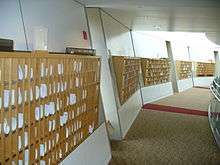Pigeon-hole messagebox


A pigeon-hole messagebox (commonly referred to as a pigeon-hole or pidge, a cubbyhole (often shortened to "cubby") or simply as a mailbox in some academic or office settings) is an internal mail system commonly used for communication in organisations, workplaces and educational institutes in the United Kingdom and other countries. Documents and messages are placed in a person's pigeon-hole for them to collect; they can reply by putting a response inside the sender's pigeon-hole.
In medieval times pigeons were kept as domestic birds, not for racing but for their meat. Pigeon holes were the openings set in a wall or a purpose-built pigeon cote in which the birds nested. By 1789, the arrangement of compartments in writing cabinets and offices used to sort and file documents had come to be known as pigeon holes because of their resemblance to the pigeon cote. By the mid 19th century, pigeon hole was being used as a verb meaning either to put a matter to one side with the intention of coming back to it later, or to classify information.[1]
Cubbies are also used in American preschools and kindergartens as places to store backpacks, lunchboxes, and jackets.
In large organisations the mailboy delivers mail to departmental pigeon holes from the postroom.
Usage of Pigeon Hole Mail Boxes
United Kingdom
Pigeon hole mail boxes are popular in the United Kingdom with postal offices allowing for easy categorising of mail for later preparation of items ready for despatch. Boxes are grouped in postcode areas with identification tabs usually fixed onto the top-left hand corner of the box allowing for easy entry and retrieval of items. Pigeon hole mail boxes can be mounted upon caster feet allowing for rearrangement of boxes to meet current processing demands.
References
- ↑ "Expressions & Sayings". tinyonline.co.uk.